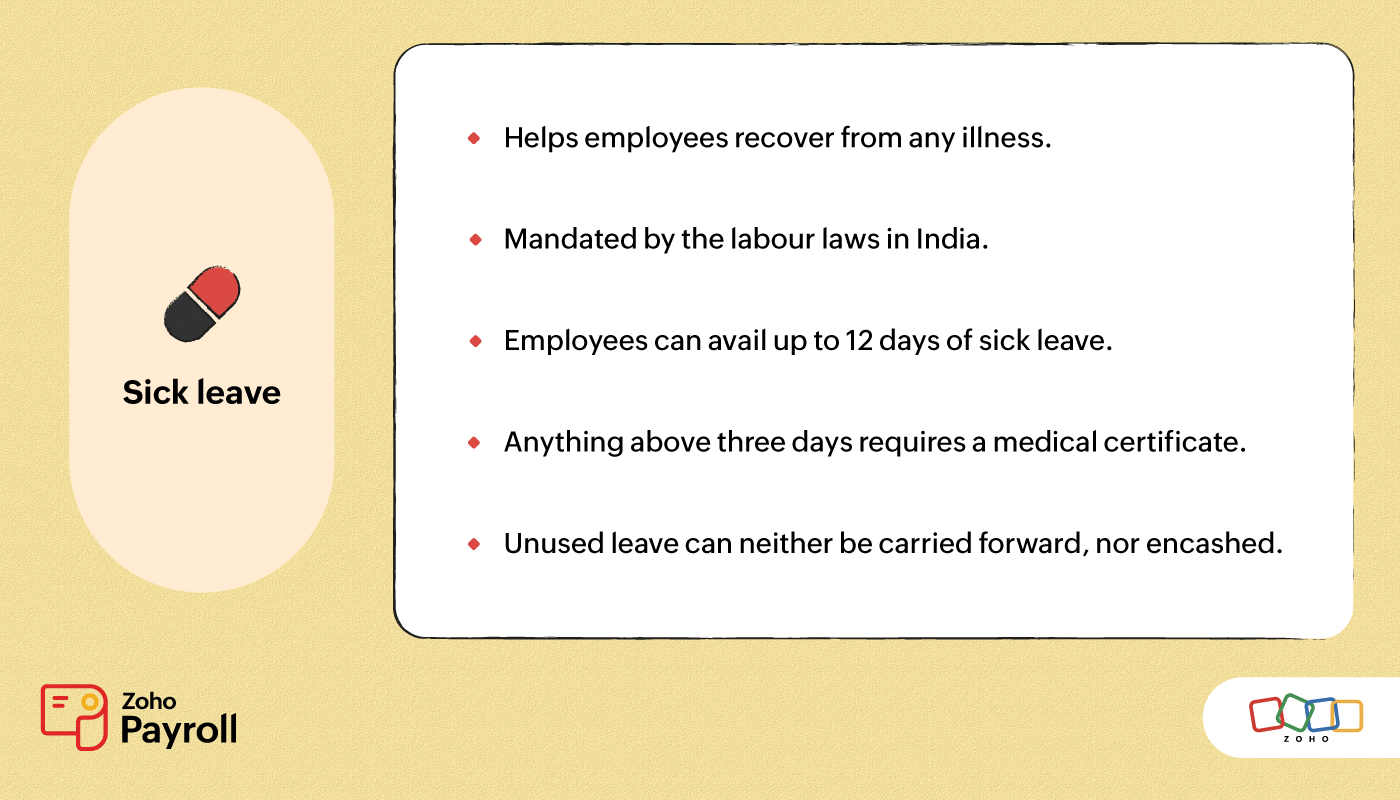- HOME
- HR and payroll
- What is sick leave? Meaning, definition and sick leave rules
What is sick leave? Meaning, definition and sick leave rules
A significant 65% of global employees believe that work-life balance is a crucial factor when choosing a job. One way employers can support this balance is by offering sufficient leave options. In India, the most common types of leave are sick leave, casual leave, and privilege leave.
In this article, we’ll understand what sick leave is, its rules, duration, and eligibility—so you can create the perfect leave policy that supports employee well-being.
What is sick leave?
Sick leave or SL is a type of leave that employees can take when they are sick or injured. The purpose of this leave is to allow employees time to recover and return to work in good health.
Sick leave is mandated by various labour laws in India, and including it in your company's policy helps ensure statutory compliance.
Sick leave rules in India
The eligibility, duration, and salary for sick leave in India are governed by the following regulations.
- Shops and Establishment Act
The Shops and Establishment Act is a state-specific law, meaning the rules can vary from one state to another. This act defines the number of leaves each employee is entitled to and sets the standards for optimal working conditions.
For instance, under the Tamil Nadu Shops and Establishment Act, employees are entitled to up to 12 days of paid sick leave and 12 days of paid casual leave each year.
- The Factories Act, 1948
Under the Factories Act, any worker who has completed 240 or more days of work in a factory during a calendar year is entitled to paid leave in the following year
This leave is calculated at the rate of 1 day for every 20 days worked. This leave can be availed by the employee in cases of illness.
- Plantation Labour Act, 1951
Similar to the Factories Act, this act also states that every plantation worker is entitled to one day of leave for every 20 days of work. This leave can be taken in case of illness, provided it is certified by a qualified medical practitioner.
- Working Journalist and Other Newspaper Employees and Miscellaneous Provisions Act, 1955
As per this act, employers in the journalism and newspaper industry must provide 1 month of sick leave to each employee after every 18 months of service. However, once an employee's accumulated sick leave reaches 90 days, no additional leave will accrue. During this leave, employees are paid at half their regular wage rate.
Sick leave policy in companies
A well-defined sick leave policy ensures that employees have the necessary support when they fall ill, while also providing clarity on the procedures regarding sick leave. Here are key points to consider when crafting your sick leave policy:
Number of sick leave can be taken in a year
Private employers usually tailor their sick leave policies to suit the nature of their work and employee needs. As a result, the number of sick leave days offered can vary from one company to another.
Most private employers in India align their SL policies with the Shops and Establishment Act, offering 12 days of sick leave and 12 days of casual leave annually.
Number of sick leave can be taken at a time
The duration of sick leave can range from half a day to 7 days. Some companies may allow employees to combine sick leave with casual leave. However, if sick leave exceeds three consecutive days, employees may be required to submit a medical certificate.
Is sick leave paid?
Yes, employers generally provide fully paid sick leave to their employees. Some companies might require a specific period of service, such as the completion of a probation period, before employees become eligible for sick leave. Additionally, some employers may offer leave without pay or Loss of Pay leave during the notice period.
Reasons for sick leave
Employers grant sick leave (SL) to their employees for several reasons, including:
- Contagious illnesses that could spread to other workers
- Doctor appointments and preventive care
- Injuries or pain
- Surgeries and hospitalisation
- Medical tests
- Chronic health conditions
What happens to unused sick leave?
Labour laws do not mandate the carrying forward or encashment of unused sick leave. As a result, any unused sick leave expires at the end of the calendar year.

How can HRs track their employees' sick leave?
Traditionally, leave tracking was done manually, but HR teams now use digital systems to manage this process. Time tracking tools can monitor employees' punch-in and punch-out times, but the most effective method is integrated HR payroll software. Using cloud-based software to handle leave applications, approvals, and tracking streamlines the entire process, making it easier and more efficient for HR to manage sick leave and other types of leave.
Frequently asked questions on sick leave
What is the meaning of sick leave?
Sick leave is paid time off provided by employers to allow employees to recover from illnesses. It usually ranges from 0.5 to 12 days per employee in a calendar year.
What is the difference between sick leave and medical leave?
Sick leave is generally short-term and paid, granted for minor illnesses lasting up to 2 weeks. In contrast, medical leave is long-term, ranging up to 1 year, and can be either paid or unpaid, depending on the severity of the employee's health condition.
What documents are required for sick leave?
Sick leave for less than 3 days usually doesn’t require documentation. However, if the leave extends beyond 3 days, a medical certificate may be required, depending on the organisation's leave policy.




